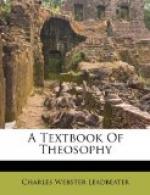The colours of the astral body bear the same meaning as those of the higher vehicles, but are several octaves of colours below them, and much more nearly approaching to such hues as we see in the physical world. It is the vehicle of passion and emotion, and consequently it may exhibit additional colours, expressing man’s less desirable feelings, which cannot show themselves at higher levels; for example, a lurid brownish-red indicates the presence of sensuality, while black clouds show malice and hatred. A curious livid grey betokens the presence of fear, and a much darker grey, usually arranged in heavy rings around the ovoid, indicates a condition of depression. Irritability is shown by the presence of a number of small scarlet flecks in the astral body, each representing a small angry impulse. Jealousy is shown by a peculiar brownish-green, generally studded with the same scarlet flecks. The astral body is in size and shape like those just described, and in the ordinary man its outline is usually clearly marked; but in the case of primitive man it is often exceedingly irregular, and resembles a rolling cloud composed of all the more unpleasant colours.
When the astral body is comparatively quiet (it is never actually at rest) the colours which are to be seen in it indicate those emotions to which the man is most in the habit of yielding himself. When the man experiences a rush of any particular feeling, the rate of vibration which expresses that feeling dominates for a time the entire astral body. If, for example, it be devotion, the whole of his astral body is flushed with, blue, and while the emotion remains at its strongest the normal colours do little more than modify the blue, or appear faintly through a veil of it; but presently the vehemence of the sentiment dies away, and the normal colours re-assert themselves. But because of that spasm of emotion the part of the astral body which is normally blue has been increased in size. Thus a man who frequently feels high devotion soon comes to have a large area of the blue permanently existing in his astral body.
When the rush of devotional feeling comes over him, it is usually accompanied by thoughts of devotion. Although primarily formed in the mental body, these draw round themselves a large amount of astral matter as well, so that their action is in both worlds. In both worlds also is the radiation which was previously described, so that the devotional man is a centre of devotion, and will influence other people to share both his thoughts and his feelings. The same is true in the case of affection, anger, depression—and, indeed, of all other feelings.
The flood of emotion does not itself greatly affect the mental body, although for a time it may render it almost impossible for any activity from that mental body to come through into the physical brain. That is not because that body itself is affected, but because the astral body, which acts as a bridge between it and the physical brain, is vibrating so entirely at one rate as to be incapable of conveying any undulation which is not in harmony with that.




